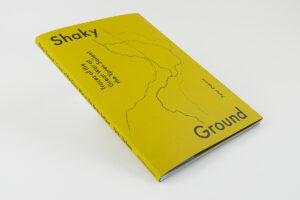YOUR CART
- No products in the cart.
Subtotal:
€ 0

Concept and photography:
Peter Dekens
Text:
Peter Dekens
Text editing and proofreading:
Joy Phillips (The Language Collective)
Narrative construction:
Peter Dekens
Rob van Hoesel
Design:
Rob van Hoesel
Cartography:
Carel Fransen
Lithography:
Sebastiaan Hanekroot (Colour&Books)
Production:
Jos Morree (Fine Books)
Print:
Wilco Art Books (NL)
Binding:
Patist (NL)
Shaky Ground originates from a childhood memory associated with the First World War. When one of Peter Dekens’ (BE) cousins tried to dismantle an unexploded shell, he was badly injured and died that same evening in the hospital.
Driving along the curve of the Ypres Front Line now, 38 years later, it’s nearly impossible to imagine that one of the most horrific wars of all time was waged here one hundred years ago. The traces of the Great War have been almost completely erased from the landscape, at least above ground. After the war, thousands of Chinese workers spent a year cleaning and restoring the landscape as much as possible. Over the course of decades, hundreds of bunkers were removed; the cleanup process continued for generations. To this very day, human remains and projectiles are still found every time someone sticks a spade into the soil. Somewhere beneath the sod, tens of thousands of missing soldiers are presumed to lie undiscovered, along with hundreds of thousands of unexploded shells. An estimated thirty per cent of the 1.5 billion projectiles fired during the First World War never went off. Some of the people who live in the area have developed a sixth sense for this hidden history: where tens of thousands of tourists and travellers pass by unknowing, the locals know that the slightest raise or dip in the road could be an indication that war remnants still lie uneasy beneath the earth.
For centuries, Europe was a divided continent with countless wars and infinite redefinitions of shared borders. It briefly seemed as though the First World War would be the very last, the ‘war to end all wars’. Ultimately, however, those years planted the first seeds of the Second World War. Long-lasting peace, prosperity and progress did not come to Europe until after 1945. The establishment of the European Community was envisioned as an affirmation of permanent peace in Europe. With the recent developments towards Brexit and the current political dynamics on the European continent, it seems that the awareness of the importance of unity stands on shaky ground again. The traces of a history of war seem to be fading rapidly from memory.
With an essay by Dutch writer and historian Guido van Hengel, about how European unification can be better understood as a project that has roots in the First World War.
Peter Dekens graduated in 2012 from the documentary photography department, St. Joost, Breda. His projects fit within a larger research domain in which Dekens is aimed at making accessible socially sensitive themes such as the social consequences of blindness, suicide and the life of a family on the periphery of society. His previous two books (Un)expected, about the grieving process of suicide relatives, and Touch, a portrait of the life of a blind boy, both received international attention and appreciation. Touch was nominated for the DutchDoc-Awards and (Un)expected was, a.o., proclaimed Photobook of the Year (PHotoEspaña), awarded at The Best Dutch Book Designs 2016 and won a Silver Medal at the Best Book Designs from all over the World in Leipzig. His latest project Shaky Ground was recently shown as a preview at BredaPhoto.